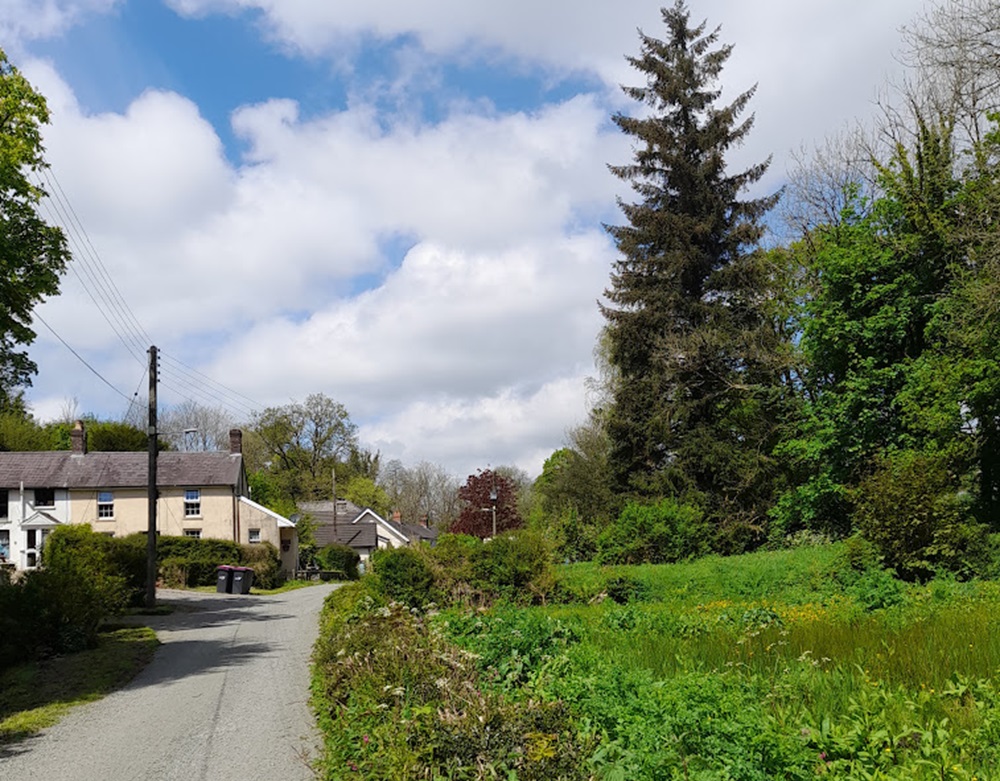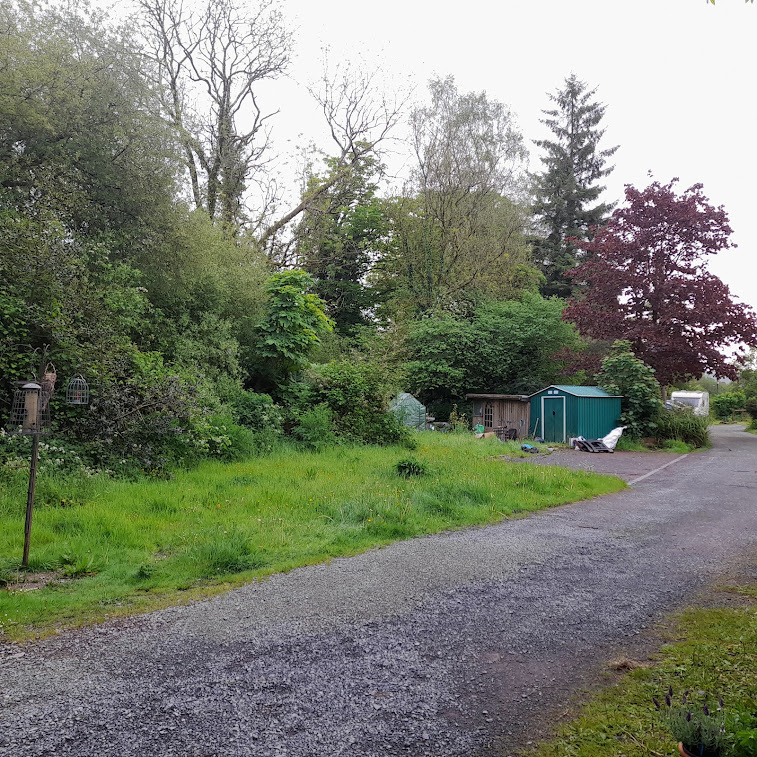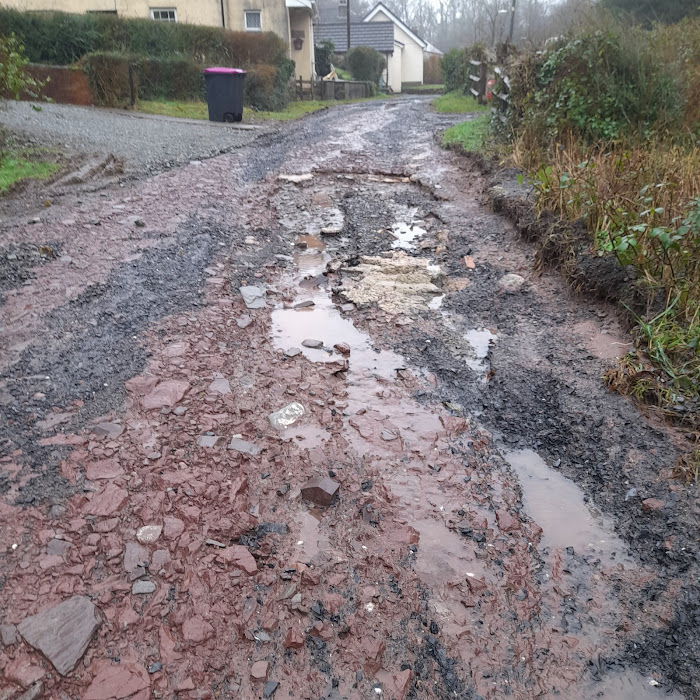Letter from Llansteffan

Mel Perry
As with many places in Wales the clue is in the name and the part of the village of Llansteffan where we live was historically known as Pwll-y-baw.
One May evening, in 1992, we took the left fork from Old School Road, down a no-through track. It was a soft evening; orange tips skittered amongst the lady’s smock or mayflower, clouds of midges twirled in soft air, wild garlic heads and dandelion clocks greeted us like cheerleader pom-poms as we crossed a bridge over a small stream.
We made our way down the lane; C19th cottages and a tumbledown shed to our left, the quiet burble of water to our right, a wide long expanse of grass opened out in front of a pair of semi-detached cottages. We were to visit, with a view to buy, the final property down Mill Pond Lane.
We could hear chiffchaff snipping the air, a great tit pumping up its bicycle tyre, and in the distance, a cuckoo called.
Alongside this patch of land is the Nant Jac, a small stream which rises up near Waun y Groes, Llanybri and runs for just over 3 km before flowing out beneath Lady Hamilton’s bridge, across and through the sand, silt, cord grass and mud onto Llansteffan beach.
Nant Jac is one of the final streams to join the Tywi, Wales’ longest river, that gargles with the Gwendraeth and Tâf, heads out into Carmarthen Bay and the Bristol Channel beyond.
We bought the house and have lived here ever since. Friends at the time said “You mind your children by that stream.”
But Nant Jac became a playground for our children and their friends; it served as a threshold for their growing up as they became old enough to build dams and dens across the stream in sight of the house, and then create their own adventure playground, out of sight, further up stream.
We have seen heron pick their way with care on caliper legs; we have seen the Pontiff-white of little egret and once, briefly, an otter mount a sprainting point on the other bank, before slinking quickly downstream.

Our house, secluded at the end of Mill Pond Lane has the highest flood risk of all the immediate properties, due to the ground floor level at the rear of the property being only marginally above the external ground level.
Nant Jac has only over-topped two to three times since we have lived here. In the last nine months we have seen marked changes in the behaviour of the stream due to a number of factors. Flood water entered the house for the first time in December 2023.
This once-benign tributary of the Tywi can roar as it now takes generally only 30-45 minutes for heavy downpours to result in complete spate, with the rise of the stream being much higher than in the past.
Noticeable now is that the water is opaque and bright pink-brown, thick with the old red sandstone silt from local fields.
Between late October 2023 and the beginning of January 2024 we experienced three major inundations from Nant Jac.
The October event followed a week of heavy sustained rain over Llansteffan and Llanybri. The main flood event was on Saturday 30th December and devastation across the village made national news.
Evidence from the rain radar in December suggests that while the weather front moved, it did so in such a way to maintain its line over our area for a number of hours with continuous heavy rain.
The January rain was sharp and relatively brief, but falling on already sodden ground and filling engorged waterways Nant Jac quickly over-topped again.
We watched as our grown up son built yet another dam, putting his well-honed skills of childhood to now protect our home.

The course of Nant Jac has been widened in some sections by almost 30% as a result of this winter’s flooding .
The lane itself became a ferocious, although temporary, river and in the brief time that water sped along it was damaged to the point of being impassable to most vehicles.
There were significant silt and clay deposits inside our property and across the yard, which are still visible today.

The changing climate with heavier, stronger rain storms and wetter winters is taking its toll.
It is evident too that new and intensive changes in farming practice are affecting Nant Jac as well as the nearby catchments leading to points along the B4312 and on the other side of the Llansteffan. Farming practice has shifted from grazing pasture to maize crops for cattle feed.
Eight years ago there was almost no maize grown within the Nant Jac catchment. Today approximately 1/5 of the catchment is maize, with no under sowing or winter cover crops visible.
This means that this area of the catchment is bare earth throughout much of the winter, and the capacity of the ground to hold water is severely compromised.
Recent slurry spreading on the maize fields to prepare for spring sowing was washed off by heavy rain which immediately ran into and blackened
Nant Jac. It’s hard to imagine our granddaughter growing up playing in the stream in the same way our children did.
As we enjoy the sunshine this May we try to recall when we last saw fish in the stream, when we last saw a heron fishing.
We hope that the delightful dippers that feed and breed here can find enough food and nest sites along the increasingly polluted water course.
We appreciate the need to produce affordable food for our communities but we hope that this can be achieved without detriment to the natural environment and wildlife.
Our minds also turn to planning how we can prepare for the next floods for ourselves, and our neighbours further downstream and elsewhere in Llansteffan.
When the recent floods were at their height Nant Jac and Mill Pond Lane converged to become one as the old name re-emerged, Pwll-y-baw, Muddy Pool.
Support our Nation today
For the price of a cup of coffee a month you can help us create an independent, not-for-profit, national news service for the people of Wales, by the people of Wales.







This piece is written entirely in English. Yet it makes a reference in the first line to the clue being in the name. If you speak Welsh, you know what “baw” is. I’m just learning Welsh, and when I first came across “baw”, it was in the context of deposits left behind by dogs, and didn’t mean “muddy”, as the final line suggests. Are we trying to spare the sensitivities of the non-Welsh-speakers reading this?
No, baw is mud in Welsh.
I’m intrigued – the writer has eloquently outlined at first hand the consequences of the unfolding climate collapse on our local area, the human cost of that and the effects modern industrialised farming practices are having on an already wildlife depleted countryside. Your take home from all of that was whether “we’re trying to spare the sensititivities of the non-Welsh speakers reading it” Rest assured, having read that your concerns are misplaced and I think we’ve all got a lot more important things to worry about, don’t you?